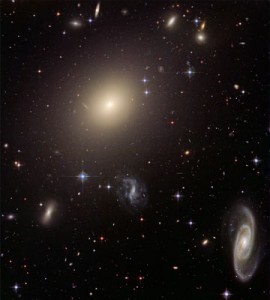What is the Size of the Universe?
The size of the universe is 46 billon light years.  This is the distance from planet Earth to the edge of the universe. 1 light year is equal to 9.46 trillion km or 5.88 trillion miles. The visible universe has a diameter of 93 billion light years.
This is the distance from planet Earth to the edge of the universe. 1 light year is equal to 9.46 trillion km or 5.88 trillion miles. The visible universe has a diameter of 93 billion light years.
The Visible / Observable Universe
The observable universe means the edge that light can travel. Remember that we see objects in the universe because of light. The distance of these objects however, means light takes a long time to travel.
When we look at the universe, we don’t see it as it is, but as it appeared billions of years ago. When looking at faraway galaxies, the light reaching us have been traversing space for billions of years. For this reason, we see the objects and the universe as it looked billions of years ago.
How does this relate to the size of the universe? It allows scientists to calculate the dimensions. Scientists determine its size by (among other methods) multiplying the age via the speed of light (186,000 miles per second). The age of the universe is estimated to be 13.7 billion years.
Beyond the Observable Universe
Of course, these calculations are limited. It only accounts for the universe which we can observe. The calculations for the dimension of the universe go back only as far as light can reach. The rest of the universe beyond light may well be much bigger.
Some make a distinction between the observable universe and the actual physical universe. The observable universe is the “edge”, the farthest light can travel. Beyond that is the rest of space.
Static and Expanding Universe
Calculating the size of the universe can become even more complicated. The measurements don’t take into account the expansion of the universe. Today a lot of scientists believe the universe is expanding. If that is the case, it means the universe is getting bigger.
For example, the galaxy that was 2 billion light years away is moving farther away. It means light has to travel much farther to reach Earth. This will affect the calculations of the universe’s dimensions.
Light that travels 13 billion light years doesn’t mean the galaxy is 13 billion years distant. With the expanding universe, it could be much farther.
Misconceptions
Various figures have been put forward as to the size of the universe. One of the most commonly reported is 13.7 billion light years. This would only hold if the universe was the flat space-time in special relativity. Because the universe is curved, this figure is not applicable.
The size of 15.8 billion light years arises from the notion that the age of the universe is equal to its radius. The figure of 27.8 billion light years is another incorrect figure often reported.
Another figure quoted is 156 billion light years. This was attained by doubling 78 billion light years. All of these figures are incorrect yet are often stated as facts in popular media.
However, even the accepted size of the universe may change. As more discoveries are made, analysis and figures concerning its dimensions and age may change again.





